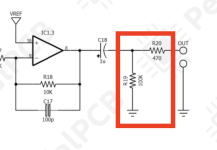Woops is my middle name
New member
I have seen many pedals using op-amp output buffers that include a resistor to ground after the output coupling cap, often 100k, and sometimes also with a small value resistor in the audio output path, like the 470 ohm below.
I'm trying to understand the purpose of these - I guess the 100k ohm would make a high-pass filter with the 1uf cap, and the 470 ohm does.... what? I get having the cap there to isolate the op-amp DC from the audio path, but not sure why you'd need a high pass filter, as opposed to just doing a 1uf cap without the resistor.
If anyone has any insight, that'd be great! This is from the Sea Horse, if that has anything to do with anything.

I'm trying to understand the purpose of these - I guess the 100k ohm would make a high-pass filter with the 1uf cap, and the 470 ohm does.... what? I get having the cap there to isolate the op-amp DC from the audio path, but not sure why you'd need a high pass filter, as opposed to just doing a 1uf cap without the resistor.
If anyone has any insight, that'd be great! This is from the Sea Horse, if that has anything to do with anything.


